小学的教案模板范文小学英语教案范文
小学英语教学设计教案范文模板

小学英语教学设计教案范文模板学英语这一时期学生的语法、词汇及会话技能构建的关键时期;处于机械记忆阶段,学得快忘的也很快,语言应用能力不强;开始需要面对学校考试的压力。
下面是给大家整理的小学英语教学设计教案,仅供参考希望能够帮助到大家。
小学英语教学设计教案1一、教材分析:本课是快乐英语第三册Unit Three,Lesson 3,歌曲教学课。
通过前两课认读表示学校各类教室及设施的单词及句型This is our school. Welcome to our school! 的学习,第三课运用歌曲形式复习巩固本单元重点内容的同时,增加学习单词art room ,sing , draw and study .和句型We all love it .We are happy.根据本单元的教学内容和学生的年龄特点,将本课主题定为:love and happy 使学生在歌唱的过程中对学校充满爱,正因为有了爱,同学才会感到快乐。
二、学习者分析:在教学方面上,注重学生的体验、实践、参与和创造性思维的发展。
教学可以根据实际进行调整,听说表演的要求分层设定目标。
教学中应当遵循全语言教学的原则。
对于词汇教学中识记词汇的处理,避免机械、无意义地操练,低年级歌曲教学的要求,如何继续保持学生学习英语的兴趣,TPR与歌曲结合,注重学生心理年龄的特点,创造性的活动。
能够通过辨别、指认校园和教师的有关图片等活动发展空间思维能力。
能够通过观察,辨认等活动发展空间思维能力。
教与学方式:根据学生已有的知识水平和年龄特点,我主要采用真实运用任务型教学法,以任务“展示我们的学校”为主导,通过向新老师介绍我们的学校为主线,培养学生综合运用本课语言,和热爱学校的积极情感。
在教学过程中恰当运用多种方法辅助教学:如采用TPR游戏活动来复习旧知,引入新知。
运用图片、教师的体态语等方式呈现本课的歌曲内容,突破本课的教学重点。
以游戏引路,让学生在“乐中玩,玩中学,学中用”,在学习中不断新知,在完成任务中滚动运用所学内容,从而将机械性的操练变成真正的意义型操练,采用“启发式、渗透式教学法”分解了本课的教学难点,为学生搭建自然习得语言的机会。
小学英语教案模板(5篇)

小学英语教案模板(5篇)最新小学英语教案模板(5篇)初步了解表示接触的指示用语,能听懂,并按指令做出相应的动作。
你会写教案吗?下面是小编为大家整理的最新小学英语教案模板,希望能够帮助到大家!最新小学英语教案模板篇1教学目标:知识与能力:1、能听懂、会说“How tall are you I’m 1.65meters. I’m taller than this one. Howtall is it”并能在情景中正确运用。
2、能够知道meter的意思能够独立完成let’s try的练习过程与方法:学生能在合作交流中使用新语言进行沟通情感与价值观:培养学生良好的英语学习习惯。
了解基本的计量单位的运用教学重点:掌握句型:How tall are you I’m 1.65meters. I’m taller than this one. How tallis it”教学难点:能在情景中正确运用所学句型并能完成调查表。
教具学具课件准备录音机及磁带、图片、学生自备一张调查表第几课时:2探索流程个性添加(教学反思)1. preparation(预习)1.日常口语练习。
2.复习单词:taller、 longer、 older、 younger 、shorter2. presentation(新课呈现)(1)Let’s try教师播放录音,学生独立完成练习并核对答案(2)Let’s talka.生阅读对话,并解释大意b.教师范读,学生跟读c.分组读,个别读回答问题d.播放录音,学到再次跟读3.practice(练习)(1).T: How tall are you I’m 1.65metres.引导学生回答,并多加练习。
(2).做完后教师出示图片问How tall are you请学生轮流回答。
(3).把图片出示给学生,让他们加强练习。
同桌或小组之间互相练习。
(4).学生两人分角色朗读课文对话。
4.homework(家庭拓展)(1).做本单元A Let’s talk部分的活动手册配套练习。
小学英语教案范文模板

小学英语教案范文(篇一)一、教材分析小学英语教学目的是激发学生学习英语的兴趣,培养他们学习英语的积极态度;使他们初步具备用因英语进展简单日常交流的才能。
掌握根本的英语交际礼貌策略,全面进步综合素质。
教材充分考虑学生个体学习才能和学习习惯的差异,设计了符合各种学习形式的练习活动,培养学生的观察、记忆、思维、想象和创造力。
二、教学目的1、养成良好的听英语、读英语、说英语的习惯。
2、初步养成良好的书写习惯。
3、能按三会与四会的要求掌握所学词语。
4、能按四会要求掌握所学句型。
5、能运用所学的日常交际用语进展简单的日常交流,并做到大胆开口,积极参与,发音清楚,语调正确。
6、能在图片、手势、情景等非语言提示的帮助下,听懂简单的话语和录音材料。
7、能在任务型学习的过程中运用相关的语言知识和技能,完成某项任务。
三、教学重点1、四会句型、单词。
2、在任务型学习的过程中运用相关的语言知识和技能,完成某项任务。
3、运用所学的日常交际用语进展简单的日常交流,并做到大胆开口,积极参与,发音清楚,语调正确。
四、教学难点:养成良好的听英语、读英语、说英语的习惯。
五、教学手段和主要措施。
1、以活动为课堂教学的主要形式2、在教学过程中,采用情景教学法3、通过听、说、读、写、唱、游、演、画、做等形式进展大量的语言操练和练习。
4、培养学生拼读音标的才能,确保学生自主学习的质量。
5、设计全面高效的课外作业,培养学生良好的书写习惯,做到整洁、标准和正确地书写。
小学英语教案范文(篇二)一.教学指导思想:根底教育阶段英语课程强调从学生的兴趣、生活经历和认知程度出发,倡导体验、理论、参与、合作与交流的学习方式和任务型的教学途径,开展学生综合语言运用才能,使语言学习的过程成为学生形成积极情感态度、主动思维和大胆理论、进步跨文化意识和形成自主学习才能的过程。
?新课标?中明确指出“教学设计要力求满足不同类型和不同层次学生的需求,是每个学生的身心得到安康的开展。
小学生英语教案范文五篇

【导语】教案是教师为顺利⽽有效地开展教学活动,根据课程标准,教学⼤纲和教科书要求及学⽣的实际情况,以课时或课题为单位,对教学内容、教学步骤、教学⽅法等进⾏的具体设计和安排的⼀种实⽤性教学⽂书。
以下是整理的《⼩学⽣英语教案范⽂五篇》相关资料,希望帮助到您。
1.⼩学⽣英语教案范⽂ 教学⽬的: 1、能听、说、辨认:hellohiname 2、认识与本课有关的⼏个⼈物:DaMing(⼤明)Amy(埃⽶)Sam(⼭姆) 教学重点、难点:单词:hellohiname 句型:Whatsyourname?Mynameis. 教学准备:词汇卡⽚三个头饰 教学过程: ⼀、开始上课 1、因为本单元是开学第⼀个单元,有很多同学对英语⼀⽆所知,所以在教课过程中,尽量使⽤简单的英语⼝语,必要的地⽅⼀定使⽤汉语教学,尽量给学⽣创设⼀个良好的学习环境,教师可以通过⼿势、表情、动作等⽰意学⽣加深理解。
如:说Standup,please和Sitdown,please时,教师可以⽤⼿势:双⼿向前平伸,⼿⼼朝上摆动⽰意学⽣起⽴, 相反表⽰坐下。
.教师⽤英语说:Nowclassbegins.然后借助⼿势让学⽣起⽴,⽤英语向学⽣问好。
T:Goodmorning,class! S:Goodmorning,teacher! 然后⽤英语说:Sitdown,please.并同时做出请学⽣坐下的⼿势。
教师向学⽣解释Goodmorning的意思,并告诉学⽣下午好应说“Goodafternoon”。
⽤⼿势介绍teacher和class这两个词,然后要全班⽤相同的语句来应答。
T:Goodmorning,class!Ss:Goodmorning,teacher!T:Goodafternoon,class!Ss:Goodafternoon,teacher! 反复训练⼏次,直到学⽣练熟为⽌。
教师可以反复重复:Standup.及Sitdown,please.等⽤语,让学⽣们做出相应的动作,直到确信学⽣已经能听懂为⽌。
英语课教案万能模板(共6篇)

英语课教案万能模板〔共6篇〕第1篇:少儿英语教案模板少儿英语教案模板一、Teaching Demands and Aims(教学目的〕二、Teaching important and difficult point (教学重点〕1、words2、sentences3、grammars三、Teaching Aids (教具)四、Teaching procedures(教学过程〕 Greeting(问候〕warm up(热身〕 Review(复习〕 New Leon(新课〕 Step One: Step Two: Step Three: Follow up(叮咛〕五、Homework(作业布置〕作业的布置一、书面作业1、每节课后老师可适中选择课后习题(书本或课外参考书〕及字母作业。
2、低年纪的孩子合适听磁带读课文、画图、连线、写字母等简单作业;每学期两次测试:半期考和期末考试。
3、高年纪的孩子要求抄单词、背单词、背课文等书面作业;每节课前可做适当的听写练习;每个月可做适当的单元测试;期间两次大考:半期考和期末考。
二、磁带作业1、适时布置(条件允答应每周一次〕:将本周学习的内容录进磁带,下周上交。
2、录制要求:首先让学生和老师打招呼,接着报朗读单元,然后录作业内容,最后与老师说再见。
(如:Hello! Amanda.I am Go go.This is Unit 11……… Goodbye! Amanda!)3、听音修正:(1)书面记录:边听边把学生的错音登记在学生手册上。
(2)修正过程:A:打招呼,先表扬肯定,后提出错误,注意错音的跟读B:说悄悄话,增进师生感情交流 C:提出问题。
D:完毕Say:“ Good bye! ”三、教学1、时间安排:每月两次的教学,每生教学时间不超过8分钟。
2、教学内容:(1)本周学习单词及课文的朗读。
(2)词句的翻译。
(3)疑难解答。
(4)家长的经历交流。
第2篇:英语课教案英语课教案范文【篇1:高中英语教案范例】新年第一节英语课〔高一教案〕step i greetings and lead in〔问候以及导入〕1.happy new year!t: well, i am so happy to see you again after the long vacation.i wish everyone of you had a happy holiday.so how about your holiday? had you done some travel? 2.learn some expreions about “dragon”〔学习一些关于中国龙的习语、成语〕 t: this year is the year of dragon, so we will play a gueing game.i will show the english expreions and you try to gue the chinese expreions, long included. step ii revision〔复习〕1.dear, how many words can you still remember after a months winter holiday?2.2.how many phrases can you still remember?3.3.do you still remember the grammar very closely?there is no shortcut in the science road ,only be deligent.在科学上没有平坦的大道,只有不畏劳苦沿着陡峭山路攀登的人,才有希望到达光芒的顶点。
小学英语教案设计思路模板【优秀6篇】

小学英语教案设计思路模板【优秀6篇】(经典版)编制人:__________________审核人:__________________审批人:__________________编制单位:__________________编制时间:____年____月____日序言下载提示:该文档是本店铺精心编制而成的,希望大家下载后,能够帮助大家解决实际问题。
文档下载后可定制修改,请根据实际需要进行调整和使用,谢谢!并且,本店铺为大家提供各种类型的经典范文,如总结报告、演讲发言、策划方案、合同协议、心得体会、计划规划、应急预案、教学资料、作文大全、其他范文等等,想了解不同范文格式和写法,敬请关注!Download tips: This document is carefully compiled by this editor. I hope that after you download it, it can help you solve practical problems. The document can be customized and modified after downloading, please adjust and use it according to actual needs, thank you!Moreover, our store provides various types of classic sample essays, such as summary reports, speeches, planning plans, contract agreements, insights, planning, emergency plans, teaching materials, essay summaries, and other sample essays. If you want to learn about different sample formats and writing methods, please pay attention!小学英语教案设计思路模板【优秀6篇】作为一位杰出的老师,通常需要准备好一份教学设计,教学设计是对学业业绩问题的解决措施进行策划的过程。
小学四年级英语教案模板七篇
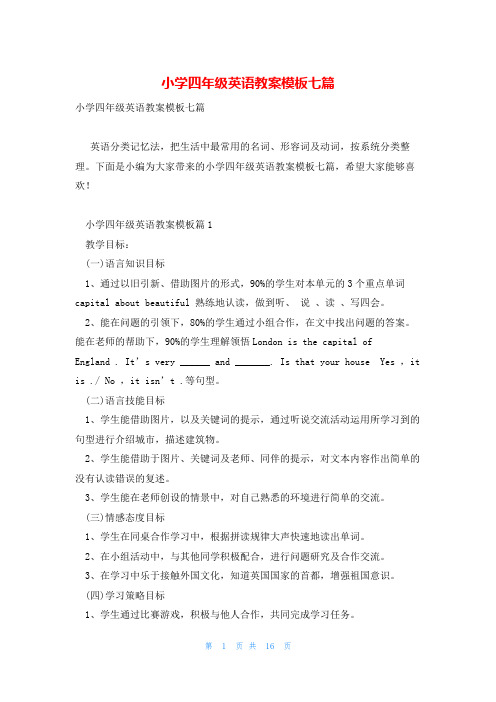
小学四年级英语教案模板七篇小学四年级英语教案模板七篇英语分类记忆法,把生活中最常用的名词、形容词及动词,按系统分类整理。
下面是小编为大家带来的小学四年级英语教案模板七篇,希望大家能够喜欢!小学四年级英语教案模板篇1教学目标:(一)语言知识目标1、通过以旧引新、借助图片的形式,90%的学生对本单元的3个重点单词capital about beautiful 熟练地认读,做到听、说、读、写四会。
2、能在问题的引领下,80%的学生通过小组合作,在文中找出问题的答案。
能在老师的帮助下,90%的学生理解领悟London is the capital ofEngland . It’s very ______ and _______. Is that your house Yes ,it is ./ No ,it isn’t .等句型。
(二)语言技能目标1、学生能借助图片,以及关键词的提示,通过听说交流活动运用所学习到的句型进行介绍城市,描述建筑物。
2、学生能借助于图片、关键词及老师、同伴的提示,对文本内容作出简单的没有认读错误的复述。
3、学生能在老师创设的情景中,对自己熟悉的环境进行简单的交流。
(三)情感态度目标1、学生在同桌合作学习中,根据拼读规律大声快速地读出单词。
2、在小组活动中,与其他同学积极配合,进行问题研究及合作交流。
3、在学习中乐于接触外国文化,知道英国国家的首都,增强祖国意识。
(四)学习策略目标1、学生通过比赛游戏,积极与他人合作,共同完成学习任务。
2、学生能在看图、说话的过程中提高自己的口语交际水平,以及与他人合作的能力。
(五)文化意识目标1、通过文本的学习,能说出英语的首都,了解了英国的重要建筑物。
2、在学习中关注中外文化的差异,在学习中增强爱国情感的体验。
(六)教学重点1、单词capital about beautiful 达到四会。
(七)教学难点1、单词 beautiful 的说、读、写。
小学英语教案20篇模板

小学英语教案20篇模板小学英语教育是学习英语的起点,也是英语教学中最重要的一环。
为了帮助小学英语教师更好的开展教学工作,不断提高学生的英语水平,很多教师都会编写英语教案。
在这里为大家提供20 篇模板,希望对小学英语教师有所帮助。
1. Title: My FamilyObjective: Students will be able to introduce their family members and talk about their family using "This is my...".2. Title: My FriendsObjective: Students will be able to introduce their friends and talk about their interests and hobbies using "He/She likes/loves..."3. Title: Daily RoutineObjective: Students will be able to describe their daily routines using "I wake up, brush my teeth, have breakfast, go to school..."4. Title: TimeObjective: Students will be able to tell the time using "It's...o'clock".5. Title: FoodObjective: Students will be able to describe different types of food and talk about their favorite foods using "I like...".6. Title: ColorsObjective: Students will be able to identify and name different colors using "What color is this?"7. Title: AnimalsObjective: Students will be able to identify and name different animals and talk about their habitats using "This is a...It lives in..."8. Title: SeasonsObjective: Students will be able to identify and name the four seasons and talk about the weather using "It's hot/cold, sunny/rainy...".9. Title: ClothesObjective: Students will be able to identify and name different clothing items and talk about what they are wearing using "I am wearing a...".10. Title: Days of the WeekObjective: Students will be able to identify and name the days of the week using "Today is...".11. Title: Months of the YearObjective: Students will be able to identify and name the months of the year using "This month is...".12. Title: WeatherObjective: Students will be able to describe the weather using "It's hot/cold, sunny/rainy...".13. Title: Family MembersObjective: Students will be able to identify and name different family members and talk about their relationships using "He/She is my...".14. Title: JobsObjective: Students will be able to identify and name different jobs and talk about what they want to be when they grow up using "I want to be a...".15. Title: EmotionsObjective: Students will be able to identify and name different emotions and talk about how they feel using "I am happy/sad/angry...".16. Title: School SubjectsObjective: Students will be able to identify and name different school subjects using "I like/dislike...".17. Title: NumbersObjective: Students will be able to identify and name numbers from one to ten using "One, two, three..."18. Title: The AlphabetObjective: Students will be able to identify and name the letters of the alphabet using "A, B, C...".19. Title: TransportObjective: Students will be able to identify and name different modes of transport and talk about how they go to school using "I go to school by...".20. Title: Places in the CityObjective: Students will be able to identify and name different places in the city and talk about their favorite places using "I like to go to the...".以上是20 篇小学英语教案模板,每个课程的目标清晰明确,教材内容深入浅出,教案结构也清晰合理。
小学英语教案万能模板【优秀10篇】

小学英语教案万能模板【优秀10篇】新标准小学英语第四册Module1 Unit1教案篇一module1 unit 1教学目标:1、掌握以下单词的读写,并能熟练使用:nice,a bit,shy,clever,naughty,2、熟练使用句子:this is . he/she is very +adj.3、会用所学的形容词语描述自己、家人和朋友。
教学重难点:1、单词的读音、拼写和运用。
2、形容词在句子中的正确使用。
教学过程:一、greetings.二、duty report.三、warming-up and reviewing.1、sing songs.2、ask and answer.如:t: thin. s: fat.复习(fat,thin,old, young,tall,short,bit,little/small)3. (出示图片)t:this is my friend ms smart. she’s a nice teacher. she’s tall and thin. à 引出课题module 1 friends unit 1 she’s a nice teacher.四:presentation1、呈现新单词:t: look, this is my family. this is my father, he is very nice. this is my mother, she is nice too, but she is a bit shy. this is my little sister, she is thin and very clever. this is my cousin, he is very naughty . we’re happy in the spring festival. (教师把绘制的“全家福”图画贴在黑板上。
)(教读新单词)nice.强调“i”的发音。
小学英语教案模板五篇
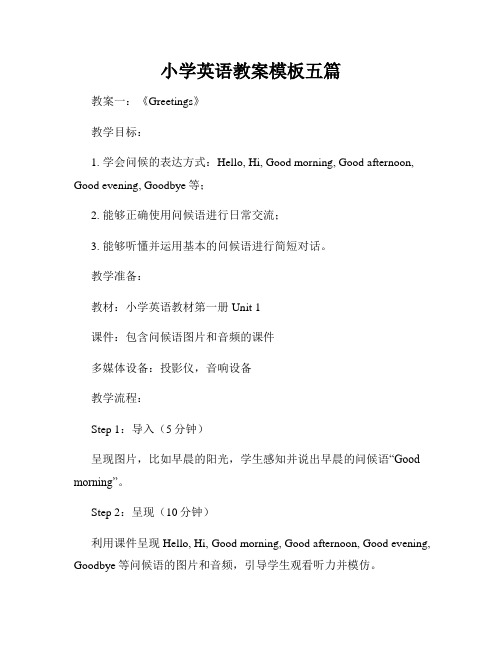
小学英语教案模板五篇教案一:《Greetings》教学目标:1. 学会问候的表达方式:Hello, Hi, Good morning, Good afternoon, Good evening, Goodbye等;2. 能够正确使用问候语进行日常交流;3. 能够听懂并运用基本的问候语进行简短对话。
教学准备:教材:小学英语教材第一册Unit 1课件:包含问候语图片和音频的课件多媒体设备:投影仪,音响设备教学流程:Step 1:导入(5分钟)呈现图片,比如早晨的阳光,学生感知并说出早晨的问候语“Good morning”。
Step 2:呈现(10分钟)利用课件呈现Hello, Hi, Good morning, Good afternoon, Good evening, Goodbye等问候语的图片和音频,引导学生观看听力并模仿。
Step 3:口语练习(15分钟)分组进行对话练习,每组两人进行问候对话练习,老师巡回指导。
Step 4:巩固训练(15分钟)学生自由搭配问候语进行对话,老师辅助纠正。
Step 5:语音训练(10分钟)利用课件中的音频进行语音训练,要求学生模仿正确发音。
Step 6:小结(5分钟)回顾今天学习的内容,总结所学的问候语,并展示学生的听说练习成果。
教案二:《Numbers 1-10》教学目标:1. 学会数字1-10的发音和书写;2. 能够听懂并正确使用数字进行简单的交流;3. 能够通过游戏等活动巩固数字1-10的学习。
教学准备:教材:小学英语教材第一册Unit 2课件:数字1-10的图片和音频游戏道具:数字卡片教学流程:Step 1:导入(5分钟)利用课件呈现数字1-10的图片和音频,引导学生观看听力并模仿。
Step 2:识字练习(10分钟)学生观看课件,边看边说,并尝试自己写下每个数字。
Step 3:听力训练(15分钟)利用课件中的音频进行听力训练,要求学生听并用数字卡片拼出正确的数字。
小学英语教案模板5篇

小学英语教案模板5篇学校英语教案模板篇1教学内容:Part B and D of Unit 11 A boy and a girl, Fun with English.教学目标:1、 Enable the Ss to understand, read and say the new words “boy, girl, Chinese, thin, fat, tall, short.”2、 Enable the Ss to use the sentence in their daily life.3、Develop the Ss' abilities of listening, speaking, and writing English.4、 Train the Ss' abilities of cooperation.重点难点:1、 The pronunciation of some new words “girl, thin, tall, small”2、 Enable the Ss to say and use the sentences“My name is …I'm …”to introduce themselves to others.教学预备:CAI、tape、recorder.教学方法:Communicational Approach教学过程:Step1、 Warm—up1、 Sing a song “Hello”。
2、 Free talkT: This is … Her name is Helen.What's your name? Nice to meet you.Step2、 Presentation & practice1、 Present and practice the new sentence “My name is …”2 T: Do you want to know my name?Ss: …T: My name is …(T presents the new sentence “My name is …”)T: My name is Zhu Xiaoyan. How about your name?S: My name is ……2、 Present and practice the new words “boy, girl, Chinese, I'm from…”T: (Show the Ss the picture of Liu Tao) Look, this is …Ss: Liu Tao. T: This is Liu Tao. So we know his name is Liu Tao.T: How about his sex?T: What's this?T: This is a Chinese flag. (Present and teach the word “boy, Chinese”)T: (point to one of them) this is a … Liu Tao is a Chinese boy.How about...? T: (point to one of them)… is a …T: Who's she? (Present the new word “girl”)T: Miss Zhu is a girl. I'm a Chinese girl. And I'm from Rudong.T: Where are you from? …(Present the sentence “I'm from…”)Do you know where is Liu Tao from?3、Present and practice the new words “fat, thin, tall, short”T: We know Liu Tao is from Shanghai. Shanghai is a beautiful city. Let's go to Shanghai.Ss: OK. T: Where is it?Ss: It's a zoo.T: Let's see what are in the zoo. (Present some pictures of animals)T: Look, this is a …(monkey) And this is a monkey. (Present and practice the word “fat, thin”)T: (Present the picture of LiuTao and Yao Ming) This is .T: Yao Ming is . (Present and practice the new word “tall, short”)4、 Present and read the textT: Now, how much do you know about Liu Tao? Say it out! …T: Let's read and learn Liu Tao's self-introduction.(Ask the Ss to read after the tape )T: Close your books, please. Look , This is Liu Tao's self-introduction, and this is me, can you help me correct it? (Ask the Ss to correct the self-introduction, and learn the example.)Step3、ConsolidationT: Now, boys and girls.Try to introduce yourselves.You have 30 seconds to do it.Step4、 Homework1、 Make your self-introduction card.2、 Introduce yourselves to five people and ask them to sign on the back of your introduction cards.板书设计:Unit 11 A boy and a girlMy name is … I'm aChinese… boy girl I'm from…I'm …(年龄) tall shortI'm …(特征) fat thin学校英语教案模板篇2一、教学内容1.词汇(略)。
小学英语教学教案七篇模板
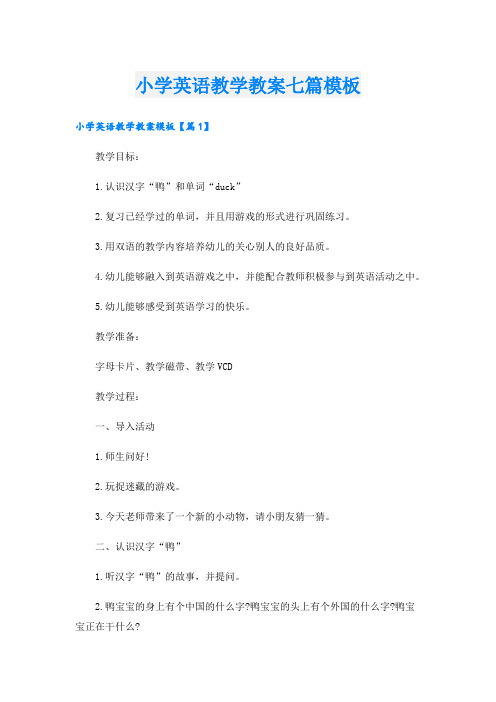
小学英语教学教案七篇模板小学英语教学教案模板【篇1】教学目标:1.认识汉字“鸭”和单词“duck”2.复习已经学过的单词,并且用游戏的形式进行巩固练习。
3.用双语的教学内容培养幼儿的关心别人的良好品质。
4.幼儿能够融入到英语游戏之中,并能配合教师积极参与到英语活动之中。
5.幼儿能够感受到英语学习的快乐。
教学准备:字母卡片、教学磁带、教学VCD教学过程:一、导入活动1.师生问好!2.玩捉迷藏的游戏。
3.今天老师带来了一个新的小动物,请小朋友猜一猜。
二、认识汉字“鸭”1.听汉字“鸭”的故事,并提问。
2.鸭宝宝的身上有个中国的什么字?鸭宝宝的头上有个外国的什么字?鸭宝宝正在干什么?3.师生一起表演这个故事。
三、认识单词“duck”1.听单词的故事,并提问:(1)鸭宝宝从农场回来后从谁的头上飞了过去?(2)鸭宝宝飞到什么里面把水喝完了?(3)谁看见了很生气地批评了鸭宝宝?(4)小朋友,你们认为鸭宝宝这样做对吗?2.集体观看单词儿歌动画片。
3.表演单词的字母组成故事。
四、听音拍手游戏。
小学英语教学教案模板【篇2】教学重点:1.掌握字母的发音和书写。
2.巩固数字30-60的拼读。
教学难点:1.Jj, Gg; Bb, Dd; Ii, Rr; Mm, Nn几组字母在发音上易混淆。
2.B, d; l, j; p, q; u, v在书写时易写错。
3.Sing and read中出现了三个新单词:jet, sugar, X’mas.要让学生做到能认读。
4.Let’s practise中两道加法题的结果出现了55、60,而前面只学到50。
教具准备:1.字母卡、加法算式卡2.有关学习物品的图片或实物。
3.Read and say部分的自制课件。
4.教材相配套的的录音带教学过程:(一)热身/复习(Warm-up/Revision)1.复习第二册教材第65页的Let’s chant。
2.做“抢读字母”的游戏。
这是一个训练学生认读字母的游戏,教师将全班分成若干小组,然后逐个出示字母卡片,学生们举手抢答,教师让最先举手的学生读出该字母,读对的给该组记10分,最后得分最多的组为优胜。
小学英语教学教案(精选5篇)
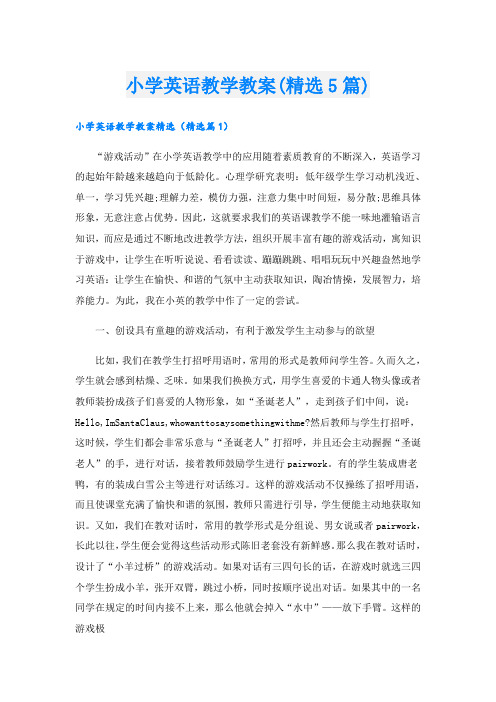
小学英语教学教案(精选5篇)小学英语教学教案精选(精选篇1)“游戏活动”在小学英语教学中的应用随着素质教育的不断深入,英语学习的起始年龄越来越趋向于低龄化。
心理学研究表明:低年级学生学习动机浅近、单一,学习凭兴趣;理解力差,模仿力强,注意力集中时间短,易分散;思维具体形象,无意注意占优势。
因此,这就要求我们的英语课教学不能一味地灌输语言知识,而应是通过不断地改进教学方法,组织开展丰富有趣的游戏活动,寓知识于游戏中,让学生在听听说说、看看读读、蹦蹦跳跳、唱唱玩玩中兴趣盎然地学习英语:让学生在愉快、和谐的气氛中主动获取知识,陶冶情操,发展智力,培养能力。
为此,我在小英的教学中作了一定的尝试。
一、创设具有童趣的游戏活动,有利于激发学生主动参与的欲望比如,我们在教学生打招呼用语时,常用的形式是教师问学生答。
久而久之,学生就会感到枯燥、乏味。
如果我们换换方式,用学生喜爱的卡通人物头像或者教师装扮成孩子们喜爱的人物形象,如“圣诞老人”,走到孩子们中间,说:Hello,ImSantaClaus,whowanttosaysomethingwithme?然后教师与学生打招呼,这时候,学生们都会非常乐意与“圣诞老人”打招呼,并且还会主动握握“圣诞老人”的手,进行对话,接着教师鼓励学生进行pairwork。
有的学生装成唐老鸭,有的装成白雪公主等进行对话练习。
这样的游戏活动不仅操练了招呼用语,而且使课堂充满了愉快和谐的氛围,教师只需进行引导,学生便能主动地获取知识。
又如,我们在教对话时,常用的教学形式是分组说、男女说或者pairwork,长此以往,学生便会觉得这些活动形式陈旧老套没有新鲜感。
那么我在教对话时,设计了“小羊过桥”的游戏活动。
如果对话有三四句长的话,在游戏时就选三四个学生扮成小羊,张开双臂,跳过小桥,同时按顺序说出对话。
如果其中的一名同学在规定的时间内接不上来,那么他就会掉入“水中”——放下手臂。
这样的游戏极富童趣,有助于克服腼腆羞愧的心理障碍,提高并保持良好的身心愉悦状态,激发主动学习的欲望,课堂气氛热烈,学生们跃跃欲试。
小学英语教案万能模板6(5篇)

小学英语教案万能模板6(5篇)利用课余时间,加强听力和阅读潜力的训练,使学生在这方面的潜力得到进一步的提高。
下面是牛牛范文整理的5篇小学英语教案万能模板6,希望能够满足亲的需求。
小学英语教师教学设计模板篇一教学目标知识目标:1. 能听、说、读、写本课四会单词:flower, grass, river, lake, forest, path.。
2、能够听、说、认读单词sky, cloud, mountain 以及句子:There is a forest in the nature park.能力目标:3. 能够完成Let#39;s find out 中找图片区别的任务。
4、学会吟唱Let#39;s chant.情感态度目标:5、培养学生热爱大自然的美好情感,增强学生的环境保护意识,热爱环境,保护环境。
教学重难点教学重点:掌握有关自然景物的单词: flower, grass, river, lake, forest, path, sky, cloud, mountain 以及句子:There is a forest in the nature park.表示景物的存在。
教学难点:本课时生词较多,充分利用视频材料及图片让学生大量练习,以较好地掌握。
教学过程(一)Warm-up(激发学生学习英语的兴趣,做好上英语课的准备。
)1、播放儿歌“It’s a Beautiful Day in the Park!”There#39;s a girl in the park. She#39;s walking in the park. It#39;s a beautiful day in the park! There#39;s a boy in the park. He#39;s running in the park. It#39;s a beautiful day in the park! There#39;s a bench in the park. A boy is sitting on the bench. It#39;s a beautiful day in the park! There#39;s a mother in the park. She#39;s pushing a stroller. It#39;s a beautiful day in the park! There are children in the park. They#39;re playing ball. It#39;s a beautiful day in the park!There#39;s a fountain in the park. A bird is splashing in the fountain. It#39;s a beautiful day in the park!2、看看说说。
中小学英语教案模板【优秀6篇】
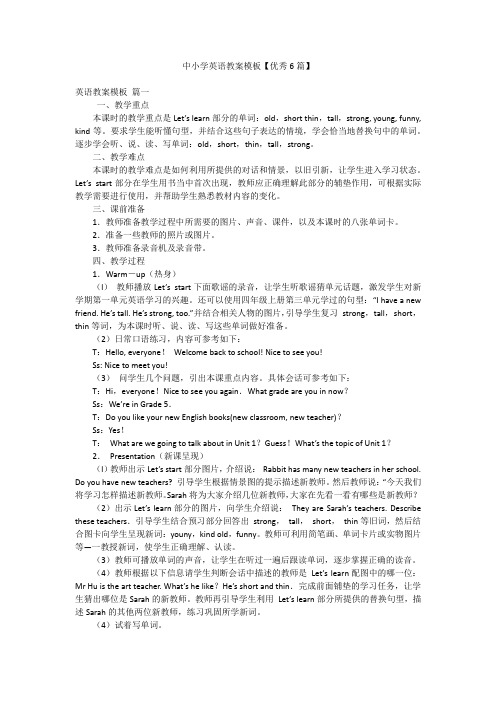
中小学英语教案模板【优秀6篇】英语教案模板篇一一、教学重点本课时的教学重点是Let’s learn部分的单词:old,short thin,tall,strong, young, funny, kind等。
要求学生能听懂句型,并结合这些句子表达的情境,学会恰当地替换句中的单词。
逐步学会听、说、读、写单词:old,short,thin,tall,strong。
二、教学难点本课时的教学难点是如何利用所提供的对话和情景,以旧引新,让学生进入学习状态。
Let’s start部分在学生用书当中首次出现,教师应正确理解此部分的辅垫作用,可根据实际教学需要进行使用,并帮助学生熟悉教材内容的变化。
三、课前准备1.教师准备教学过程中所需要的图片、声音、课件,以及本课时的八张单词卡。
2.准备一些教师的照片或图片。
3.教师准备录音机及录音带。
四、教学过程1.Warm-up(热身)(l)教师播放Let’s start下面歌谣的录音,让学生听歌谣猜单元话题,激发学生对新学期第一单元英语学习的兴趣。
还可以使用四年级上册第三单元学过的句型:“I have a new friend. He’s tall. He’s strong, too.”并结合相关人物的图片,引导学生复习strong,tall,short,thin等词,为本课时听、说、读、写这些单词做好准备。
(2)日常口语练习,内容可参考如下:T:Hello, everyone!Welcome back to school! Nice to see you!Ss: Nice to meet you!(3)问学生几个问题,引出本课重点内容。
具体会话可参考如下:T:Hi,everyone!Nice to see you again.What grade are you in now?Ss:We’re in Grade 5.T:Do you like your new English books(new classroom, new teacher)?Ss:Yes!T:What are we going to talk about in Unit 1?Guess!What’s the topic of Unit 1?2.Presentation(新课呈现)(l)教师出示Let’s start部分图片,介绍说:Rabbit has many new teachers in her school. Do you have new teachers? 引导学生根据情景图的提示描述新教师。
人教版小学英语教案模板(通用10篇)
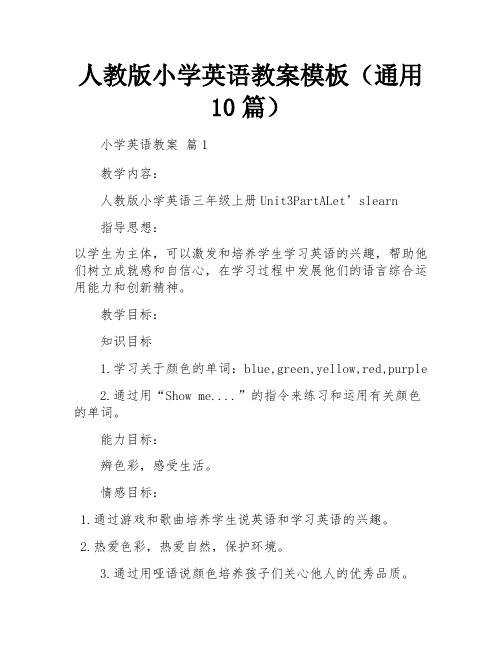
人教版小学英语教案模板(通用10篇)小学英语教案篇1教学内容:人教版小学英语三年级上册Unit3PartALet’slearn指导思想:以学生为主体,可以激发和培养学生学习英语的兴趣,帮助他们树立成就感和自信心,在学习过程中发展他们的语言综合运用能力和创新精神。
教学目标:知识目标1.学习关于颜色的单词:blue,green,yellow,red,purple2.通过用“Show me....”的指令来练习和运用有关颜色的单词。
能力目标:辨色彩,感受生活。
情感目标:1.通过游戏和歌曲培养学生说英语和学习英语的兴趣。
2.热爱色彩,热爱自然,保护环境。
3.通过用哑语说颜色培养孩子们关心他人的优秀品质。
教学重、难点:1.听,说,读五个颜色单词。
2.会说唱Let’s do,并会听音做出相应的反应。
教具准备:1.教师准备blue,green,yellow,red,purple的单词卡片和颜色卡片。
老师和学生准备红色、黄色、蓝色、绿色和紫色的蜡笔。
3.教师准备色彩教学课件。
4.老师把学生学过的文具准备好,放在书包里。
教学教程:Warm-up:(1)师生之间相互问候:T:Good morning/Good afternoon/Hello,boys and girls.S:Good morning/Good afternoon/Hello,teacher/....T:How are you?S:Fine,than kyou./I’mfine,thank you/....(2)游戏T:Let’s playa game,OK?S:OK.“猜一猜”的游戏。
将学生学过的文具放入书包中,让学生摸一摸,猜一猜。
从而复习学过的文具词。
【说明:“猜一猜”的游戏能调动学生大脑中所有相关记忆,使学生回忆起所有知道的有关文具的单词。
】(3)课件出示学过的文具用品:卷笔刀(红色),钢笔(绿色),铅笔盒(蓝色),书(黄),书包(绿色),蜡笔(紫色)。
小学英语教案模板范文5篇
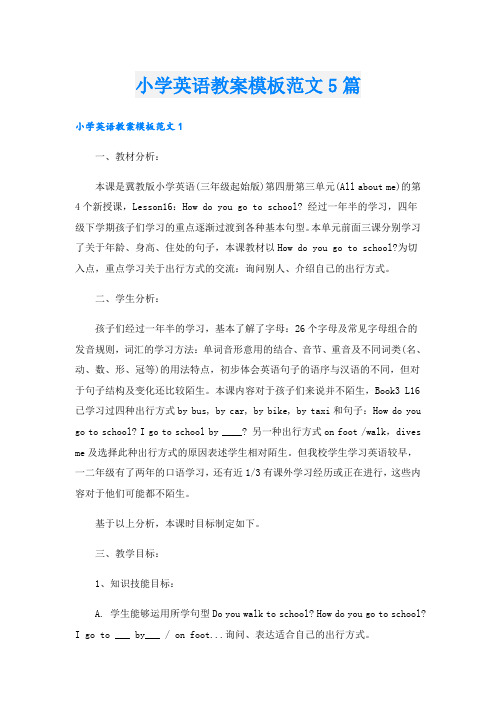
小学英语教案模板范文5篇小学英语教案模板范文1一、教材分析:本课是冀教版小学英语(三年级起始版)第四册第三单元(All about me)的第4个新授课,Lesson16:How do you go to school? 经过一年半的学习,四年级下学期孩子们学习的重点逐渐过渡到各种基本句型。
本单元前面三课分别学习了关于年龄、身高、住处的句子,本课教材以How do you go to school?为切入点,重点学习关于出行方式的交流:询问别人、介绍自己的出行方式。
二、学生分析:孩子们经过一年半的学习,基本了解了字母:26个字母及常见字母组合的发音规则,词汇的学习方法:单词音形意用的结合、音节、重音及不同词类(名、动、数、形、冠等)的用法特点,初步体会英语句子的语序与汉语的不同,但对于句子结构及变化还比较陌生。
本课内容对于孩子们来说并不陌生,Book3 L16已学习过四种出行方式by bus, by car, by bike, by taxi和句子:How do you go to school? I go to school by ____? 另一种出行方式on foot /walk,dives me及选择此种出行方式的原因表述学生相对陌生。
但我校学生学习英语较早,一二年级有了两年的口语学习,还有近1/3有课外学习经历或正在进行,这些内容对于他们可能都不陌生。
基于以上分析,本课时目标制定如下。
三、教学目标:1、知识技能目标:A. 学生能够运用所学句型Do you walk to school? How do you go to school?I go to ___ by___ / on foot...询问、表达适合自己的出行方式。
B. 学生知道句子的变化是和人称有关系的,并能尝试运用所学句子介绍和询问他人的出行方式:Does he/she walk to school? How dooes he/she go to school? He/she goes to school by___ / on foot...2、文化目标:尝试了解不同地区人们选择不同出行方式:山区孩子、牧民(草原)、江南居民及西方国家等。
小学英语教案全英文版范文
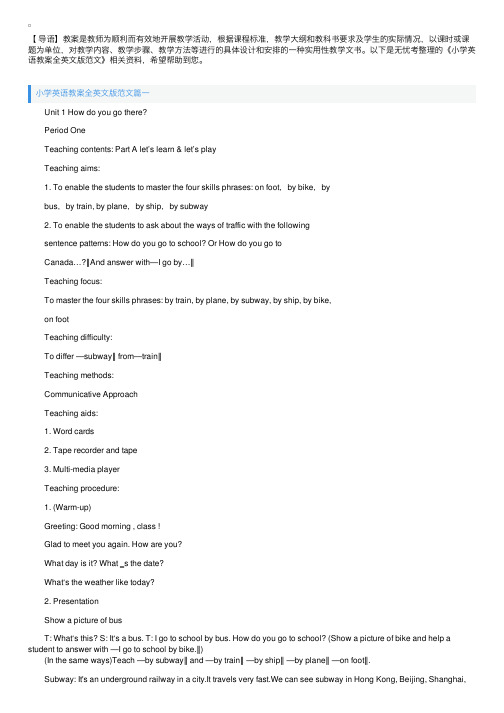
【导语】教案是教师为顺利⽽有效地开展教学活动,根据课程标准,教学⼤纲和教科书要求及学⽣的实际情况,以课时或课题为单位,对教学内容、教学步骤、教学⽅法等进⾏的具体设计和安排的⼀种实⽤性教学⽂书。
以下是⽆忧考整理的《⼩学英语教案全英⽂版范⽂》相关资料,希望帮助到您。
⼩学英语教案全英⽂版范⽂篇⼀ Unit 1 How do you go there? Period One Teaching contents: Part A let’s learn & let’s play Teaching aims: 1. To enable the students to master the four skills phrases: on foot,by bike,by bus,by train, by plane,by ship,by subway 2. To enable the students to ask about the ways of traffic with the following sentence patterns: How do you go to school? Or How do you go to Canada…?‖And answer with―I go by…‖ Teaching focus: To master the four skills phrases: by train, by plane, by subway, by ship, by bike, on foot Teaching difficulty: To differ ―subway‖ from―train‖ Teaching methods: Communicative Approach Teaching aids: 1. Word cards 2. Tape recorder and tape 3. Multi-media player Teaching procedure: 1. (Warm-up) Greeting: Good morning , class ! Glad to meet you again. How are you? What day is it? What ‗s the date? What‘s the weather like today? 2. Presentation Show a picture of bus T: What‘s this? S: It‘s a bus. T: I go to school by bus. How do you go to school? (Show a picture of bike and help a student to answer with ―I go to school by bike.‖) (In the same ways)Teach ―by subway‖ and ―by train‖―by ship‖―by plane‖―on foot‖. Subway: It's an underground railway in a city.It travels very fast.We can see subway in Hong Kong, Beijing, Shanghai,Gongzhou… Explain the differences between subway and train Pay attention to the pre. ― by‖& ―on‖ 3. Play games Ask one S to the front and stick the word cards next to the phrases written on the Bb when T read the new phrases quickly and the other Ss put up their cards. The one who reflect fastest and correctly is the winner. 4. Listen to the tape of Part A Let‘s learn and follow it. Pay attention to the tone and pronunciation 5. Practice: Let‘s play T Offer many places (the USA. England Australia Hong Kong Shanghai Guangzhou the moon…) and traffic ways (by car/ taxi/ bus… on foot) Ss practice with above places and ways in pairs: A: How do you go to school? B: I go to school on foot . Encourage the Ss to make up as many sentences as they can. 6. Spelling competition Divide the class into tow groups. Show the pictures of traffic tools and ask Ss to spell the phrases. The first one who puts up hand gets the chance to spell. The group spell out more phrases are the winners. Homework Copy the new words and phrases Finish Page1 of the AB⼩学英语教案全英⽂版范⽂篇⼆ Goood moring, I'm glad to interpret my lesson here . The lesson plan I am going to talk about is Part A let's learn of unit1 PEP Primary English book7. I will explain how to teach and the reason for doing this from following aspects. Ⅰ analysis of the teaching content. Ⅱ ways of teaching and learning . Ⅲ teaching procedures Ⅳ blackboard design V assessment Now Let’s focus on the analysis of teaching content. It can be divided into 3 parts as followed: the status and the function, the teaching objectives , the main points and difficult points, I’ll talk about it one by one. This lesson is the first lesson of unit 1, book7 . It includes two parts: Let’s learn and let’s play. In section 1, it mainly deals with these key phrases: on foot, by bike, by bus, by train, by subway. And in section 2, it provides a game for the Ss to prastise the patterns: How do you go to…? And the answer: I go… by../ on foot. Our students have already known some vehicles in the daily life. It’s not difficult for them to understand and use these words . If students can learn it well, it will help students to learn the rest of this unit. So, I set the following aims: The first is language objectives To make sure that students can read, recognize and use these key phrases :on foot ,by bike,by bus,by train skillfully. The next is ability objectives (1) To develop Ss’ abilities of listening and speaking. (2) To train the Ss’ ability of working in groups. moral objectives (1)to help students know some vehicles and comprehend the traffic rules (2) To foster Ss’ consciousness of good co-operation and proper competition. The main points and difficult points about this lesson is: (1) To make sure that Ss can use these key phrases correctly and skillfully. (2) To enable Ss to study in groups and co-operate skillfully. (3) To develop Ss’ interest in English. Difficult points To help the Ss ask and answer the question “How do you go to…? part Ⅱways of teaching and learning As we all know: the main instructional aims of learning English in primary school is to cultivate pupils’ basic abilities of listening and speaking and their good sense of the English language. So in this lesson I’ll mainly use “Task-based” teaching method. That is to say, I will let the Ss learn in real situations, finish a task by making a survey”How do you go to school?” to help Ss to get a better understanding of the key phrases. I will arrange these activities: guessing game, finishing a survey and having a competition. And in this lesson a recorder, CAI, will be needed. partⅢ teaching procedures I’ll finish this lesson in five steps. step1 lead--in activities I will begin my class with "drawing and guessing" game, just like this : I show students some vehicles such as bike ,bus ,jeep which they learned before by "Stick Figures" and ask them guess what’s it. Purpose: It is important to form a better English learning surrounding for the Ss by guessing game. and at the same time it provides situations to review learned knowledge for the next step. step2 prestentation Now I’ll mainly talk about this step. 1、first there is a Free talk between T and Ss. For example: I show many pictures of beautiful cities and ask students some questions, such as "do you like this city?where do you want to go ?"and help Ss to answer them with "by train ,by plane,by ship". By the way, I show the picture of a school, and say“ I go to schiool by bus” ,Ss read this sentence. do the actions and ask "how do you go to school?",show many pictures of tools such as ,on foot by bike ,by bus to help students answer my question one by one. To present the key structures one by one is much easier for the Ss to learn and grasp the meanings. 2 With the help of the CAI I set a situation to help Ss understand the way of using these key phrases: A boy is coming, who is going to school. He says: I go to school by.Then play the sounds of bus, bike ask students to listen carefully and tell “I go to school by." according to the different sounds, by the way , I present another new phrases:by subway Purpose:Make Ss use these new phrases with sentence structures, to help Ss use the language in a real situation.。
- 1、下载文档前请自行甄别文档内容的完整性,平台不提供额外的编辑、内容补充、找答案等附加服务。
- 2、"仅部分预览"的文档,不可在线预览部分如存在完整性等问题,可反馈申请退款(可完整预览的文档不适用该条件!)。
- 3、如文档侵犯您的权益,请联系客服反馈,我们会尽快为您处理(人工客服工作时间:9:00-18:30)。
小学的教案模板范文小学英语教案范文Unit1 My new teachers第一课时教学重点本课时的教学重点是Let’s learn部分的单词:old,short thin,tall,strong, young, funny, kind等。
要求学生能听懂句型,并结合这些句子表达的情境,学会恰当地替换句中的单词。
逐步学会听、说、读、写单词:old,short,thin,tall,strong。
二、教学难点本课时的教学难点是如何利用所提供的对话和情景,以旧引新,让学生进入学习状态。
Let’s start部分在学生用书当中首次出现,教师应正确理解此部分的辅垫作用,可根据实际教学需要进行使用,并帮助学生熟悉教材内容的变化。
三、课前准备1.教师准备教学过程中所需要的图片、声音、课件,以及本课时的八张单词卡。
2.准备一些教师的照片或图片。
3.教师准备录音机及录音带。
四、教学过程1.Warm-up(热身)(l)教师播放Let’s start下面歌谣的录音,让学生听歌谣猜单元话题,激发学生对新学期第一单元英语学习的兴趣。
还可以使用四年级上册第三单元学过的句型:“I have a new friend. He’s tall. He’s strong, too.”并结合相关人物的图片,引导学生复习 strong, tall, short,thin等词,为本课时听、说、读、写这些单词做好准备。
(2)日常口语练习,内容可参考如下:T:Hello, everyone! Wele back to school! Nice to see you!Ss: Nice to meet you!(3) 问学生几个问题,引出本课重点内容。
具体会话可参考如下:T:Hi,everyone!Nice to see you again.What grade are you in now?Ss:We’re in Grade 5.T:Do you like your new English books(new classroom, new teacher)?Ss:Yes!T: What are we going to talk about in Unit 1?Guess!What’s the topic of Unit 1?2. Presentation(新课呈现)(l)教师出示Let’s start部分图片,介绍说: Rabbit has many new teachers in her school. Do you have new teachers? 引导学生根据情景图的提示描述新教师。
然后教师说:“今天我们将学习怎样描述新教师。
Sarah将为大家介绍几位新教师,大家在先看一看有哪些是新教师?(2)出示Let’s learn部分的图片,向学生介绍说: They are Sarah’s teachers. Describe these teachers.引导学生结合预习部分回答出 strong, tall, short, thin等旧词,然后结合图卡向学生呈现新词:youny,kind old,funny。
教师可利用简笔画、单词卡片或实物图片等—一教授新词,使学生正确理解、认读。
(3)教师可播放单词的声音,让学生在听过一遍后跟读单词,逐步掌握正确的读音。
(4)教师根据以下信息请学生判断会话中描述的教师是 Let’s learn配图中的哪一位: Mr Hu is the art teacher. What’s he like?He’s short and thin.完成前面铺垫的学习任务,让学生猜出哪位是Sarah的新教师。
教师再引导学生利用 Let’s learn部分所提供的替换句型,描述Sarah的其他两位新教师,练习巩固所学新词。
(4)试着写单词。
教师范写四会单词,让学生跟写或在单词卡片背面仿写,达到听、说、读、写四会掌握新词的目的。
3.Let’s play (趣味操练)(1)Let’s find out (找一找)教师指导学生用所学新词和句型描述Let’s find out部分几位教师的体貌特征,然后找出正确的图片。
完成这项活动后,教师引导学生充分利用八张新词卡片继续进行结对或小组活动,如: My new Chinese teacher is tall and strong. Who is he? 让其他学生选出正确的图片。
(2)Let’s sing (唱一唱)教师放歌曲“My new teacher”的录音,学生跟唱,进一步在音乐节奏中感知新词。
4.Consolidation and extension(巩固与扩展)(l)让学生做本单元 A Let’s learn部分的活动手册配套练习。
(2)让学生模仿Let’s find out部分的录音,读给朋友或家长听。
展示不同教师的图片,让学生猜出是教哪个科目的教师,然后用所学新词描述这些教师的外貌特征。
(3)让学生参照 Let’s find out部分设计一些谜语让大家清一猜。
可以参考以下语言: She is tall. She’sbeautiful. She’s very young. We all like her. Who’s she?(4)让学生把新学的歌曲唱给家长或朋友听。
5. 小结单词:old,short thin,tall,strong, young, funny, kind教案点评:提供第一课时教案示例。
本课时Let’s learn部分主要是通过情景会话,谈论美术教师的样子,来让学生学习单词:old,short thin,tall,strong, young, funny, kind等。
教学设计适合与学生身边的人物相联系,尤其是新老师。
可引导学生复习已学过的tall, short, thin, strong等词汇,再进一步学习本课新生词。
达到描述不同图片人物的要求。
利用一些活动来巩固知识。
教师引导学生充分利用事先准备好的人物图片,进行结对或小组活动,如: My new Chinese teacher is tall and strong. Who is he? 让其他学生选出正确的图片。
Unit1 My new teachers第二课时一、教学重点本课时的重点掌握句型是: Who’s your math teacher? Mr Zhao. What’s he like? He’s thin and short. He’s very kind要求学生能在相似的情景中完成替换练习。
能灵活运用这些句子进行交际。
二、教学难点Let’s try这一形式在学生用书中第一次出现,但难度不大。
学生即使不能够听懂句子的含义,只要明白关键词语的意思也能找到正确答案。
教师要帮助学生听录音熟悉新词和新句型,感知连读、失去爆破和弱读等语音现象。
初步培养学生的听力技能。
三、课前准备1.教师准备教学过程中所需要的图片、声音、课件,人物图片最好是能够直接粘贴在黑板上。
2.准备一些教师的照片或图片。
3.教师准备录音机及录音带。
四、教学过程1.Warm-up(热身)(1)教师放歌曲“My New Teacher”,让学生感知并复习歌曲中语言。
(2)结合画有人物不同相貌特征的教学图片进行关键词的替换,引导学生复习上一课时所学的新词,为本课时学习句型做好准备。
口语练习内容可参考如下:A: Good morning/afternoon. Look! Our math teacher is very young. He’s tall and thin.B: This is our music teacher. She’s young. She’s very funny.A: Who’s your art teacher?B: Mr Hu.A: What’s he like?B: He’s short and thin!2. Let’s try and talk (操练)Let’s try反复播放Let’s try部分录音,指导学生根据声音选出图中相应的人物。
在学生根据录音内容圈出所描述教师之后,可让学生看一看他们熟悉老师的图片,用英语说出他们是谁,用句型:“Who’s he/ she? What’s he / she like? ”提问学生。
此后再转入Let’s talk部分对话的详细学习。
教师最好能放一句,停一句,并重复录音中的话语,帮助学生掌握正确的语音、语调。
Let’s try部分录音内容如下:① Boy:Who’s your English teacher?②Girl:Who’s your math teacher?Girl: Mr Black. Boy: Mr Li.Boy: What’s he like? Girl: What’s he like?Girl: He’s tall and strong.Boy: He’s old.He’s very thin.Who are the two men they are talking about?Let’s talk(1)教师播放Let’s learn A中的四句话(声音见媒体素材的A learn sentences.wav)。
教师说:“这位胡老师又瘦又矮,我们找一找图中的哪位老师又瘦又矮呢?”出示Let’s talk部分的人物图片,让学生快速找出Mr Zhao。
然后教师分别说出教师姓氏:Mr Ma/ Miss Liu….这时先不要求学生描述这些教师,可把该项任务放到对话教学之后。
(2)听录音,跟读Let’s talk部分的对话。
引导学生指现图中的人物Mr Zhao是English teacher, 而录音中的人物说的是math teacher。
(3)教师再次出示人物图片,让学生分别并对人物进行描述,可利用句型:“Who’s this man / woman? What’s he/she like?”进行操练,先由教师示范,再结对或分小组进行。
Good to know此部分为选学内容,要求学生了解中西方国家在人名称呼习惯上的不同。
汉语中习惯把姓放首位,名字放在后面。
英语国家的人却习惯把名放在首位,家族的姓氏放在后面,而且有的在两者之间还有中间名(middle name)。
这些不同需要让学生了解。
3.Consolidation and extension(巩固与扩展)(l)让学生做A部分Let’s talk的活动手册配套练习。
(2)让学生默记Let’s talk部分的录音,将内容说给家长或朋友听。
(3)让学生利用新学的文化背景知识,试着与同学进行交流,可分别扮演不同国家的人物。
再用英语写一写自己扮演的名字。
